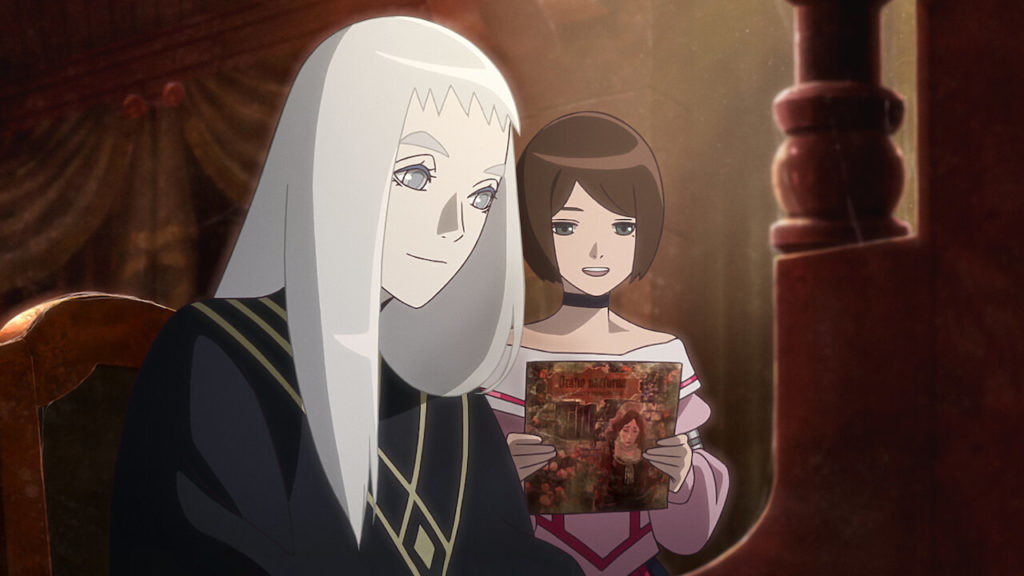Vampire in the Garden
October 26, 2023 · 0 comments
By Andrew Osmond.

Vampire in the Garden is a girl-meets-girl story, set in a wintry wonderland. One girl is human, the other a vampire, but they share a longing to escape their world of war and death. It’s very plainly a girls’ love story, though some viewers may complain that it can’t fully speak its name, in the manner of many same-sex anime. Other viewers will be too swept up in the tale’s beauty to care.
It’s set in a world where humans and vampires have long been at war. The anime is made by the Wit Studio, and one way to see Vampire in the Garden is as a riff on Wit’s famous action titles, Attack on Titan (which Wit made until 2019) and Kabaneri of the Iron Fortress. Both anime also showed humans in wars against “monstrous” enemies, and Vampire asks what if two people in this situation, each from a different side, deserted together. Fans of Attack on Titan may remember season two’s plotline about the girls Ymir and Christa (as she was known then); that also had memorable scenes in a snowy landscape.

In Vampire in the Garden, though, the setting is Russia. Location scouting was done in the Republic of Karelia, north of Moscow, a region also known as the “Songland” for its rich folktale traditions. There was a trip to the island of Kizhi, famed for its beautiful wooden churches, which involved crossing a huge frozen lake on snowmobiles. “The journey to get there was seriously hard,” recalled director Ryotaro Makihara of a journey that took seven or eight hours on ice. “It really kind of felt like a journey to some otherworldly place.”
Another section of the story takes place in a palatial dacha (Russian country home), complete with a greenhouse, evoking Doctor Zhivago as much as Dracula. Like Titan and Kabaneri, Vampire also has an air of history-jumbling steampunk. The monsters and landscapes evoke old folktales, but the humans use bulky mecha that fire missiles, and aim spotlights and floodlights against the glare-averse vampires.
Some of the vampires are portrayed as aristocrats, harking back to the days of Dracula. The main one is Fine, a vampire queen who begins the story in a debauched, world-weary state. We see her dallying with her female favourites, and dismaying many of her subjects – especially Allegro, her dashing male guardian. One tweak on the normal mythology is that the vampires inject themselves with a special serum to take on their full monstrous forms – another link to Attack on Titan.

Another new idea is that vampires are especially sensitive to sound, and particularly music. That’s now forbidden in human society, symbolising how this conflict is stealing away people’s souls. The ban on music is especially mourned by the anime’s human heroine, Momo, who’s starting to despair of her life much as Fine is of hers. When the girls meet in battle, they end up running off together, and gradually bonding over music and song.
Naturally, there are both humans and vampires in pursuit of the couple. The vampire faction is led by Allegro, determined to retrieve his queen. The humans are directed by Momo’s cold-seeming mother, a commander whose authority has been jeopardised by her daughter’s desertion.
For their part, Momo and Fine are drawn by rumours that somewhere in this world there’s a paradise, a place where humans and vampires can live together freely. As they travel deeper and deeper into the cold and dark, you might be reminded of a vintage anime series from twenty years back – Wolf’s Rain by the Bones studio, where wolves disguised as humans sought paradise through a similarly wintry wasteland. In Vampire, though, we’re more concerned with the uncertain relationship between the girls; whether it’s built on true love or lonely fantasy, and if it’s as doomed as everyone insists it is.
Originally broken up into pieces for Netflix serialisation, the anime is the creation of Ryotaro Makihara, who wrote, directed and storyboarded it. He said Fine and Momo’s story was inspired by the feelings of defiance he remembers from the start of his anime career, when he was constantly told it would never work out and he should choose another life. Before Vampire in the Garden, Makihara directed another intimate story of a doomed-seeming “romance,” Wit Studio’s film Hal, about a human and an android. He also directed an epic steampunk vision in the film The Empire of Corpses, while his other credits include work on both Kabaneri and Attack on Titan.
And since we’ve mentioned the latter anime so much, it would be wrong not to note that the vampire queen Fine is voiced in Japanese by Yu Kobayashi. She also voiced Sasha in Attack on Titan – yes, the giant-killing girl who loved potatoes more than anything else in the world.
Andrew Osmond is the author of 100 Animated Feature Films.
Vampire in the Garden: Feature Supercut with director Q&A is screening at the Glasgow Film Theatre in November.
Leave a Reply